Although we might think of Santa and an evergreen Christmas tree as inevitably wedded in nineteenth-century children’s book illustration, that was not necessarily the case. Until about 1840, New Year’s Day was favored over Christmas as the family-appropriate winter holiday in the young American Republic, particularly in New England, where the descendants of the 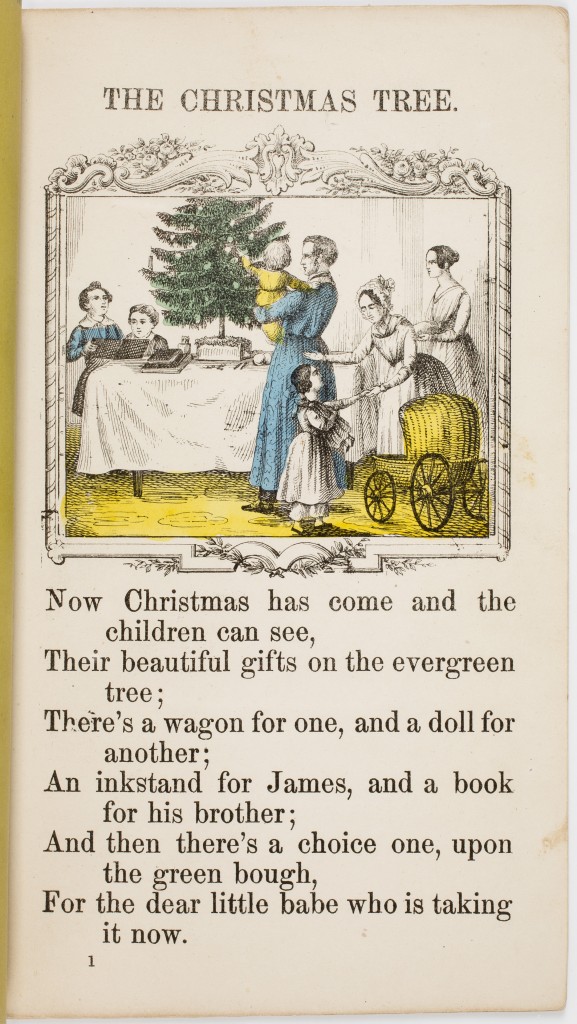 Puritans cast a dim eye upon the Christmas holiday with its Roman Catholic roots. However, with the influx of German immigrants to the United States in the 1840s, the celebration of Christmas and the use of the Christmas tree gained a toehold in American culture. Many of the newly arrived Germans settled in Philadelphia; among them were skilled book artists like lithographer Augustus Kollner (b. 1813).
Puritans cast a dim eye upon the Christmas holiday with its Roman Catholic roots. However, with the influx of German immigrants to the United States in the 1840s, the celebration of Christmas and the use of the Christmas tree gained a toehold in American culture. Many of the newly arrived Germans settled in Philadelphia; among them were skilled book artists like lithographer Augustus Kollner (b. 1813).
Kollner illustrated several picture books published in Philadelphia by the American Sunday-School Union, one of most prolific children’s book publishers operating before the Civil War. AAS recently acquired a copy of the ASSU picture book Life in the Nursery. The Christmas Tree; it was issued circa 1844-1853, and contains one of the earliest children’s picture book illustrations that we have of a Christmas tree. It shows a hand-colored lithograph of the lower half of a tabletop Christmas tree modestly decorated with a few ornaments and a few candles. The image is not religious, but rather family-centered: children are looking up at the tree and the gifts on the table. The parents are in control of the situation: the father holds a very young child, and the mother extends a hand to her daughter, gesturing to the tree. The accompanying text gives us an introduction to the Christmas tree as panacea of gifts: “Now Christmas has come, and the children can see, / Their beautiful gifts on the evergreen tree/; There’s a wagon for one, and a doll for another…” Although this poem and picture describe an evergreen tree, this image was not yet culturally embedded as what constitutes a proper Christmas tree.
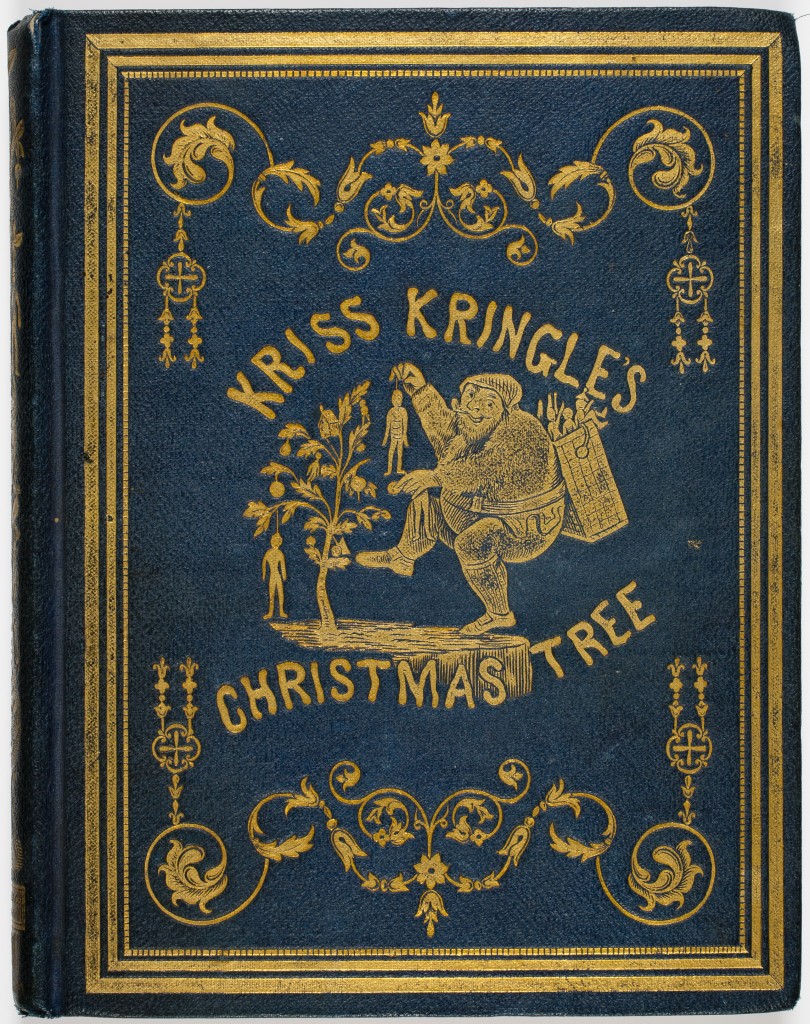 The cover design for Kriss Kringle’s Christmas Tree, also published in Philadelphia at about the same time, in 1846, shows a rotund, elfish Santa putting gifts from his backpack onto a short, deciduous tree. This collection of brief stories includes “The Christmas Tree”—a tale about an impoverished child who receives a vision of the Christ child showing him a star-spangled Christmas tree up in the heavens.
The cover design for Kriss Kringle’s Christmas Tree, also published in Philadelphia at about the same time, in 1846, shows a rotund, elfish Santa putting gifts from his backpack onto a short, deciduous tree. This collection of brief stories includes “The Christmas Tree”—a tale about an impoverished child who receives a vision of the Christ child showing him a star-spangled Christmas tree up in the heavens.
In 1860, the New York-based General Protestant Episcopal Sunday School Union published A Christmas Tree for Christ’s Children. It too featured a non-evergreen tree: according to the book’s first chapter, the tree is a novelty; it is an orange tree brought into the parlor from the home’s conservatory and decorated with dolls, candy, and wax lights by Mr. & Mrs. Oldham for their children’s delight and religious instruction. The frontispiece (below) shows the children gathered around the newly decorated Christmas tree under the direction of their father, who points out the religious significance of the various ornaments; for example, a toy soldier represents the belief that when one is baptized, he becomes a soldier of Christ.
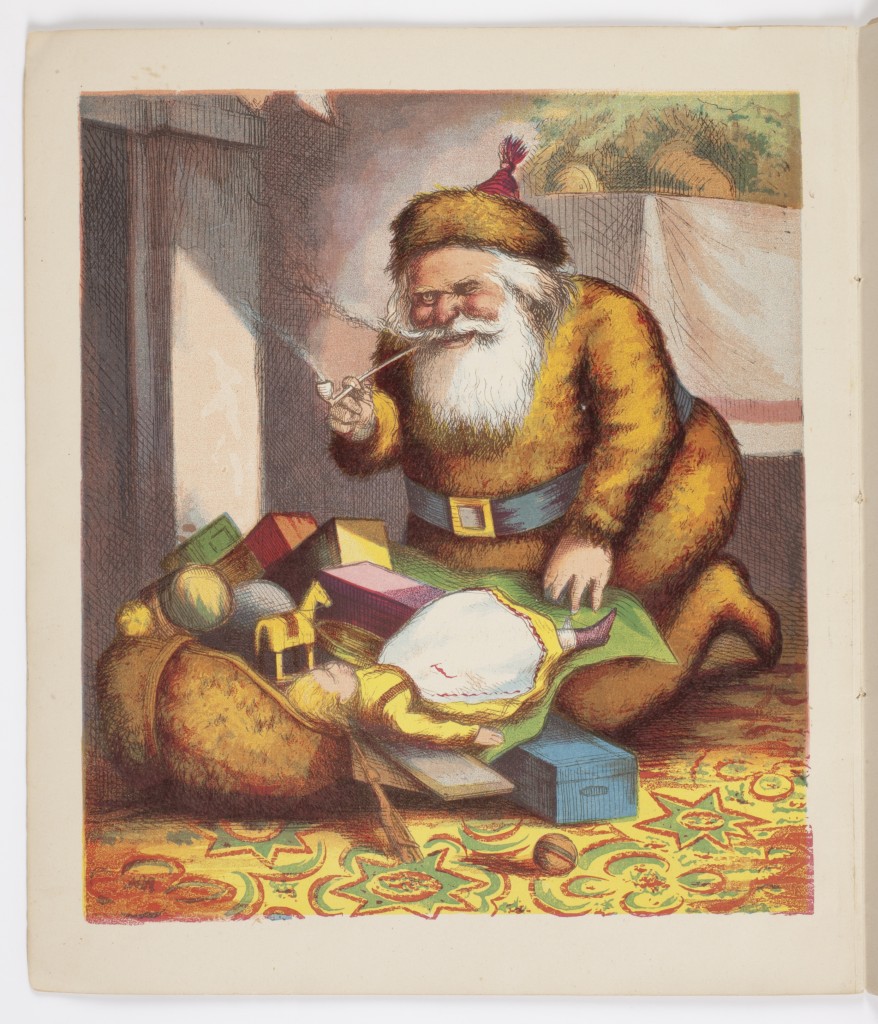 Although the first picture book version of Clement Clarke Moore’s poem The Night Before Christmas was issued in 1848, arguably it is Thomas Nast’s illustrations some twenty years later for New York publisher McLoughlin Brothers that shaped the American cultural image of a rotund, fur-suited, pipe smoking Santa that we recognize today (see right). But even then, Santa appears crouched over his gifts with a tabletop Christmas tree just barely visible in the upper right hand corner of the picture.
Although the first picture book version of Clement Clarke Moore’s poem The Night Before Christmas was issued in 1848, arguably it is Thomas Nast’s illustrations some twenty years later for New York publisher McLoughlin Brothers that shaped the American cultural image of a rotund, fur-suited, pipe smoking Santa that we recognize today (see right). But even then, Santa appears crouched over his gifts with a tabletop Christmas tree just barely visible in the upper right hand corner of the picture.
It would take an ongoing infusion of German immigrants and German language picture books like the edition of Gustav Erlenkotter’s Poetischer Jugendschatz in Bild und Spruch (New York, ca. 1870-1885) seen below to build a solid iconographic bond between Santa and the Christmas tree. In this case “Ruprecht” (Father Christmas or Santa Claus) rides a horse co-piloted by a cherubic angel bearing a lit Christmas tree (what a headlight!).
In the late nineteenth century, Moore’s reindeer-driving St. Nick and the Germanic Ruprecht bearing the Christmas tree on horseback became merged, resulting in this fantastical cover image for The Night Before Christmas issued by McLoughlin Brothers in 1899. We see a Santa driving a packed sleigh laden with not only gifts, but a full-sized, decorated Christmas tree; it is as if Santa is bringing all of the Christmas trappings to families everywhere.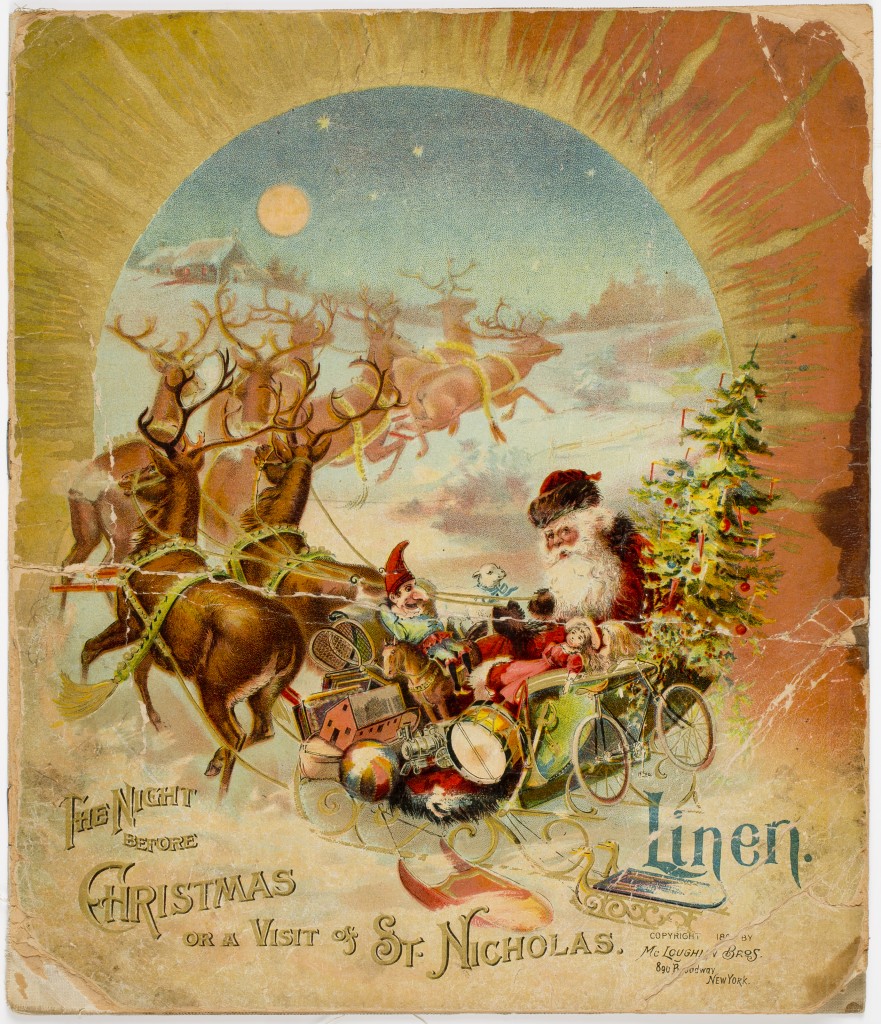
And what is the end result of Santa’s delivery? This magnificent, tall Christmas tree, loaded with ornaments and small gifts, sheltering the larger gifts placed around it (below). Santa and the Christmas tree both came of age in America in the latter half of the nineteenth century, and their story unfolds in the pages of children’s picture books with whimsical splendor.

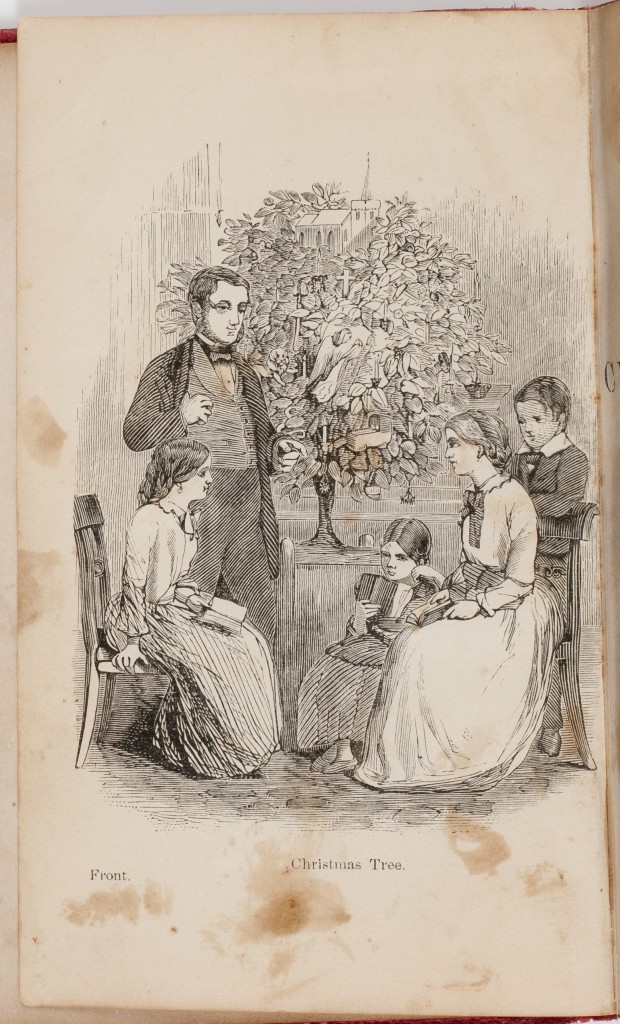

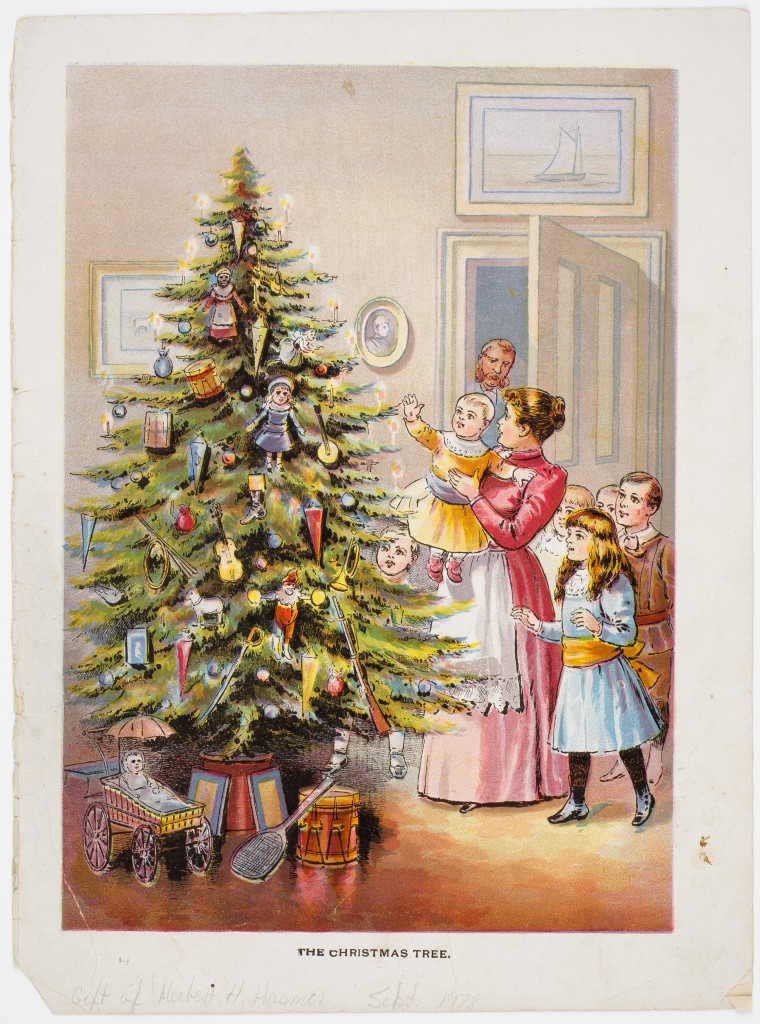
2 thoughts on “Santa and the Christmas Tree in Nineteenth-Century American Children’s Books”